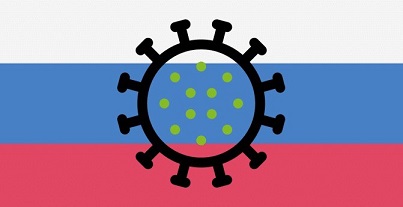BREAKING COVID-19 News! Russia Reports 107,174 New SARS-CoV-2 Infections Mostly Driven By JN.1, 9451 Hospitalizations, 148 Deaths For Epi Week 49!
Nikhil Prasad Fact checked by:Thailand Medical News Team Dec 13, 2023 1 year, 4 months, 1 week, 9 hours, 3 minutes ago
COVID-19 News: JN.1 and its sub-lineages are driving a worrisome SARS-CoV-2 surge in Russia with hospitals in Moscow and St. Petersburg running short of hospital beds and outpatient clinics witnessing a constant stream of sick individuals.

According to local Russian
COVID-19 News, coverages, data from official Russian sources shows that for the epidemiological week of 49 of 2023 spanning from December 4th to December 10th, Russia has seen a significant increase in both COVID-19 infections and also COVID-19 hospitalizations. The latest data reveals that 9,451 individuals were hospitalized during this period, marking a 5.2% rise compared to the previous week.
https://xn--90aivcdt6dxbc.xn--p1ai/stopkoronavirus/v-rossii-za-nedelyu-vyzdorovelo-97-345-chelovek/
The surge in hospitalizations is widespread, affecting 44 regions of the Russian Federation, with 22 regions experiencing an increase above the national average.
Alarmingly, despite low COVID-19 testing rates, the 7 days saw about 107,174 new SARS-CoV-2 Infections!
The weekly incidence rate of the new coronavirus infection per 100,000 population stands at 73.39, representing a 9.7% uptick from the previous week.
This rise in COVID-19 infection rates was observed in 51 regions, with 26 regions exceeding the national average.
Tragically, 148 lives were lost to theSARS-CoV-2 virus in the same week.
JN.1 Variant And It Sub-lineages Causing Havoc.
According To local Russian doctors and researchers, the BA.2.86 variant especially the JN.1, JN.1.1, JN.1.1.1. JN.1.2, JN.3 and JN.4 sub-lineages are now constituting almost 30 percent of all variants in circulation but it does seem to be driving disease severity.
At present there are about 1,802 individuals in ICU needing ventilator support. In coming weeks, the COVID-19 death rates are expected to increase.
Odd Symptoms
Local doctors are saying that many of the cases due to JN.1 or any of its sub-lineages do not typically exhibit symptoms associated with upper or lower respiratory infections initially.
Many of the infected are developing fevers in the early days of infections along with headaches, abdominal pains and discomfort along with diarrhea, loss of appetite and in some cases even intestinal bleeding. As days progresses, only then are persistent coughs, breathing issues and chest pains and chest discomfort seen.
Regional Breakdown of COVID19 Infections.
Central Federal District:
The Central Federal District, including Moscow, reported 2,603 hospitalizations, 27,275 recoveries, 29,305 new cases, and 44 fatalities.
North-West Federal District:
This region recorded 16,031 hospitalizations, 8,889 recoveries, 22,325 new cases, and 37 fatalities.
Southern Federal District:
The Southern Federal District documented 4,852 hospitalizations, 7,553 recoveries, 5,352 new cases, and 7 fatalities.
Volga Federal District:
The Volga Federal District reported 18,471 hospitalizations, 9,677 recoveries, 15,462 new cases, and 20 fatalities.
Ural Federal District:
In the Ural Federal District, there were 9,341 hospitalizations, 10,695 recoveries, 8,961 new cases, and 17 fatalities.
Siberian Federal District:
The Siberian Federal District witnessed 13,731 hospitalizations, 11,660 recoveries, 13,340 new cases, and 16 fatalities.
Far Eastern Federal District:
The Far Eastern Federal District reported 4,164 hospitalizations, 7,384 recoveries, 4,463 new cases, and 3 fatalities.
Moscow and St. Petersburg:
Moscow, the capital city, reported 14,331 hospitalizations, 16,940 recoveries, 15,855 new cases, and 30 fatalities. St. Petersburg documented 5,051 hospitalizations, 2,440 recoveries, 2,782 new cases, and 6 fatalities.
Conclusion
The latest data underscores the dynamic nature of the COVID-19 situation in Russia, with a notable surge in hospitalizations and recoveries. Authorities will need to closely monitor and adapt public health measures to effectively respond to the evolving situation. As the nation grapples with these challenges, it becomes imperative to maintain vigilance, adhere to safety protocols, and expedite vaccination efforts to curb the impact of the virus.
